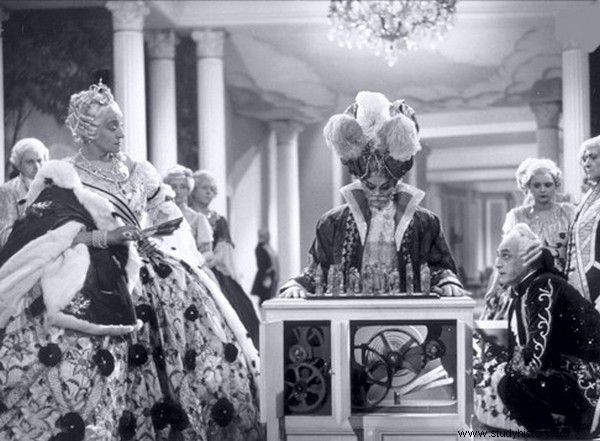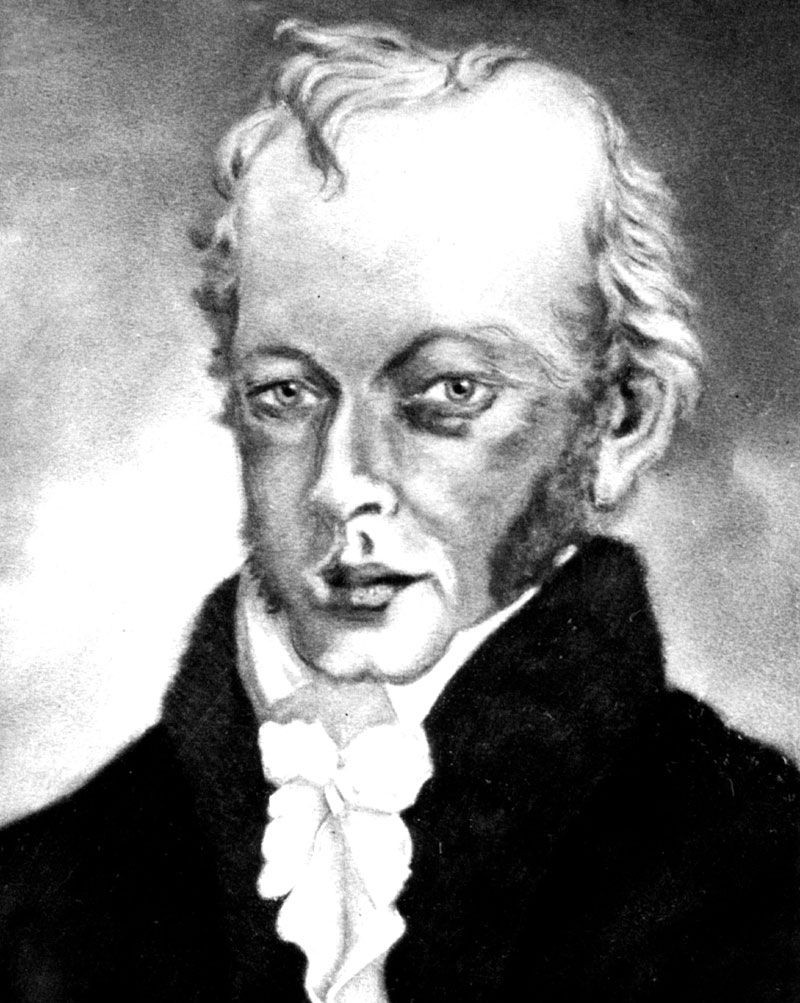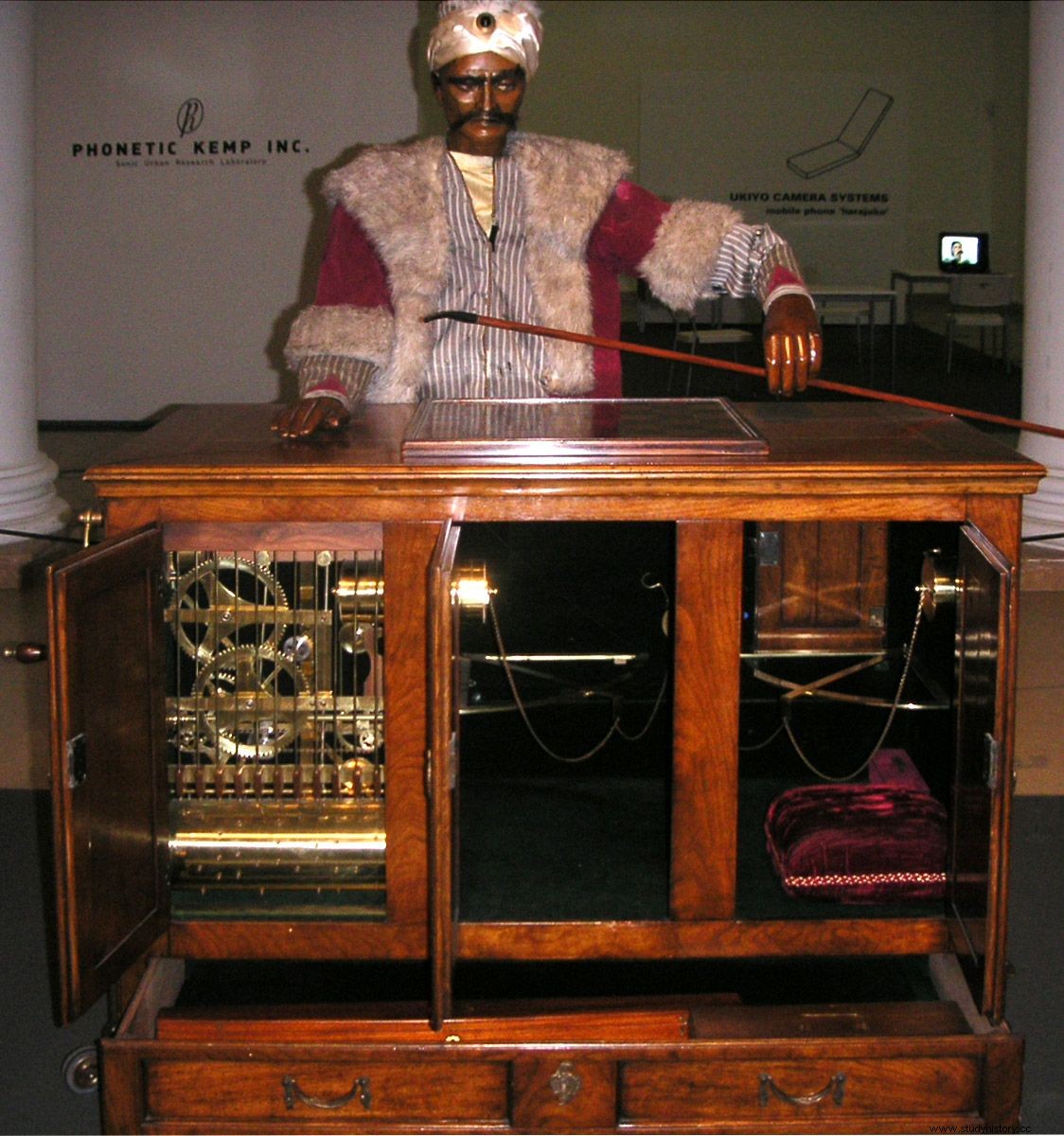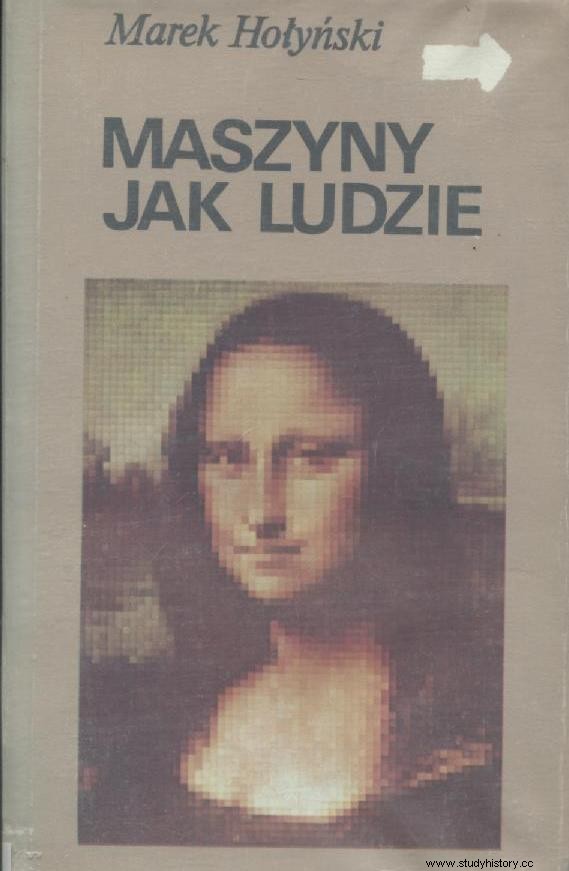250 years ago no one dreamed that artificial intelligence would take over the world. At least to anyone except the Russian Tsarina. Without hesitating, she declared war on the robots. And apparently she even went so far as to carry out executions on an overly intelligent machine ...
The year is 1777. Tsarina Catherine II sits in the game of chess with an automaton created by the designer Wolfgang von Kempelen. This automaton - a kind of android, humanoid robot - specializes in chess. And he looks like a Turkish pasha, so he is called a Turk.
The tsarist game is clearly not going. So he starts cheating. Then the android angrily knocks the pieces off the board. The courtiers are appalled. It's sabotage! Betrayal! Von Kempelen pales in terror.
The Tsarina sentences the android . The Turk with his accessories (a desk with a checkerboard on top, to which he was attached) is to be arrested. Then he is put in front of a firing squad and shot!

Cards from the movie "Le Joueur d'échec", showing the Turk and Catherine II playing a game of chess.
Rescue for a Polish officer
This story is told by two French films entitled "Le Joueur d'échecs" - from 1927 (silent) and 1938 (sound). Their source is a story spread in the nineteenth-century press.
It was presented by the famous French illusionist Jean-Eugène Robert-Houdin (it is in his honor that the American master Houdini will later choose his nickname); as proof, he showed a ticket confirming tour played by the chess android around Russia in 1777.
And why was it the illusionist who dealt with the Turk? Because the android-chess player himself was a clever hoax! According to Houdin's information, it was as follows:a Hungarian builder, van Kempelen, visiting Russia, a doctor he knew asked to hide a Polish officer named Woroński .

Jean-Eugène Robert-Houdin himself. It is thanks to him that the story of the alleged duel between the Turk and Catherine II became so popular (source:public domain).
Fighting the tsarist army, the Pole was seriously injured and lost both legs. From 1776, he hid with a doctor and had to leave Russia as soon as possible. Von Kempelen found an excellent hiding place:inside his machine, pretending to be an automatic chess player, but actually controlled by a man hidden under the chessboard!
Humiliate Katarzyna
Woroński turned out to be great in this game. By means of a hidden mechanism, he flawlessly steered the Turk's movements and won again and again. In this way, they traveled peacefully around Russia. They did not foresee only one thing: the fame of the machine that wins over people will make the tsarina herself want to look at it!
She summoned Kempelen and his Turk to St. Petersburg. The constructor was afraid that he would end his adventure in Siberia, but eventually took the risk and appeared at Catherine's court as instructed.
Together with him, Woroński, hidden in the chest of a Turk who was ready to risk his life to defeat the Tsarina. He - sentenced to the life of an invalid, coming from a mutilated country - wanted to teach the Russian ruler a lesson of humility . It also happened.
It sounds unbelievable, but is this just an empty fantasy?
Great game
Not necessarily! First, the Turk really existed. He played for the first time in 1769. And in fact, it was a hoax that many designers, players and writers had long tried to figure out. They didn't believe the machine was playing by itself, but couldn't prove cheating.

This is what the Turek was supposed to look and act like (source:public domain).
Von Kempelen installed a clever system of mirrors in the desk's chest, masking the spaces in which a man could hide. And inside there were really good chess players, hired by the constructor.
Secondly, the tsarina was really interested in technical novelties and accumulated automatons . For her collection, she even caught a large clock with life-size moving birds made of gold:a peacock, an owl and a rooster.
This article has more than one page. Please select another one below to continue reading.Attention! You are not on the first page of the article. If you want to read from the beginning click here.
She bought this work of British constructor James Cox in 1781. Today it is (and still works!) In the St. Petersburg Hermitage Museum. Let us add that Katarzyna herself also became an automaton with time, or in fact an automaton - in a jewelery egg by the famous Faberge from 1914, she moves on a litter, carried by two black servants.
Third, the original story of Woroński as told by Houdin did not end with Catherine II shooting the android, as is the case in the film, but much more likely.

Wolfgang von Kempelen, founder of The Turk (source:public domain).
The Tsarina likes the Turk and she wants to buy him back (suspecting perhaps that there is a man inside and wanting to check it for herself), but von Kempelen disagrees and leaves for England.
What is truth and what is rumor?
In fact, the Hungarian constructor traveled with his automaton around Europe, gaining great fame. At the "home" court in Vienna in 1780 a chess player was presented to the tsarina's son, Paweł.
There were also rumors that more than a quarter of a century later Napoleon himself joined the chess game with the Turk (which was used by Waldemar Łysiak in his novel "The Chess Player", describing the backstage of an alleged British conspiracy against the French leader using an automaton), and when the emperor tried to cheat, he provoked an angry reaction from the machine.

Contemporary reconstruction of the Turk (photo:Carafe; license CC BY-SA 3.0).
Perhaps it is on the basis of these anecdotes that the nineteenth-century story about the game of the Russian empress with the invention of von Kempelen was created. But where did the Polish officer come from in the background of this story? We'll probably never find out about that.
Although, who knows? It is worth mentioning that for many years there was a belief that the original copies of the Turk (designed by von Kempelen, and then his Maelzel imitators) were lost. And then suddenly in 1945 Allied soldiers found a copy in occupied Vienna , in the basement of an old, dilapidated house! So maybe someday we will also find the trail of the mysterious Woroński?
Robot army
It is a pity that this Polish thread in the history of the mechanical Turk is practically forgotten today, as are both French black and white films.

By the way, there is also the theme of the vile Major Nikolaev, who took on von Kempelen, in them. Eventually, this evil Russian dies at the hands of ... the constructor's androids . Dressed in uniforms, armed with bayonet rifles, the robots turn Nikolayev into a rag.
This is proof that filmmakers were afraid of humanoid machines long before Ridley Scott's famous Blade Runner (1982). By the way, it will be continued soon.
Could our filmmakers make a remake of "Le Joueur d'échecs"? It's a sure success in Polish cinemas.
Bibliography:
- The Automaton Chess-Player , in The Living Age, No. 784, June 4, 1859, pp. 585-592.
- The Automaton Chess-Player , in The National Magazine, vol. 5, pp. 307-312.
- Jerzy Giżycki, With chess through centuries and countries , Sport and Tourism 1960, pp. 117–124.
- Magnus Magnusson, Famous Forgeries, Scams and Scandals , Bellona 2008, pp. 206–223.
- Waldemar Łysiak, Szachista [novel], Warsaw 1980, pp. 30-31.
- Robert Löhr, Chess Player [novel], Wydawnictwo Dolnośląskie 2007, pp. 319–321.
- Marek Hołyński, Machines like people , Iskry 1984, pp. 82-83.
